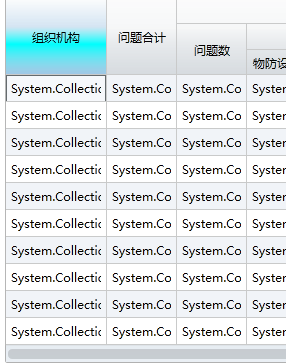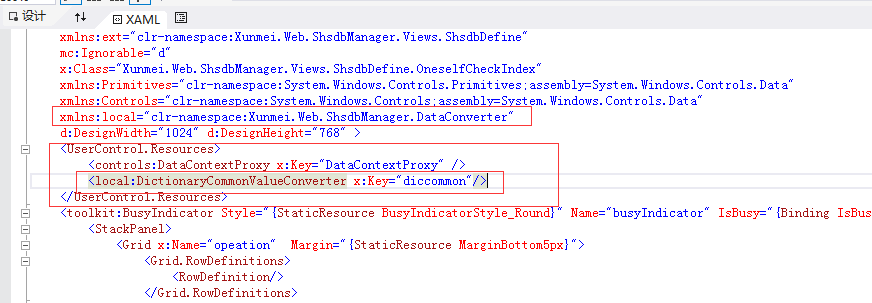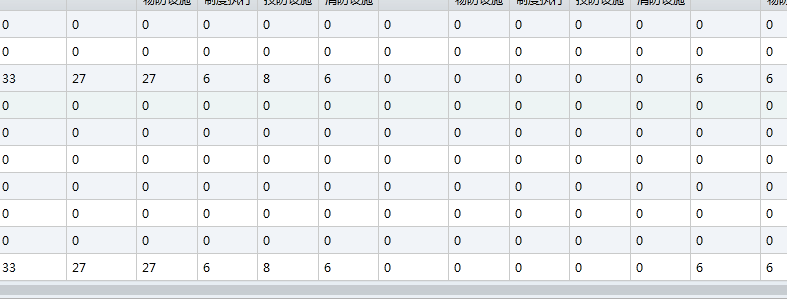SliverLight注册字典转换器方法
SliverLight注册资源——本处以添加字典转换器为列。
该列子中,是动态添加DataGrid复杂表头,而数据源是字典集合,因此使用传统的数据绑定就不能(个人能力)实现。
添加表头并绑定数据代码如下。

其中ColumnItem是找的一个dll中的方法,该dll主要就是为了动态创建复杂表头而生,此处不做过多解释。第一个参数是表头名称,第二个参数是数据字典Key,第三个参数是字典转换器,第四个参数是数据显示位置,第五个参数是列宽。
如果不绑定第三个参数,则不能正常显示数据,显示情况如下:

这里重点描述第三个参数的由来:dicCommonValueConverter是字典转换器注册别名。
字典转换器的类:
public class DictionaryCommonValueConverter : System.Windows.Data.IValueConverter { /// <summary> /// /// </summary> /// <param name="value"></param> /// <param name="targetType"></param> /// <param name="parameter"></param> /// <param name="culture"></param> /// <returns></returns> public object Convert(object value, Type targetType, object parameter, System.Globalization.CultureInfo culture) { if (value == null) { return null; } IDictionary<string, object> dic = value as IDictionary<string, object>; if (dic == null) { return null; } object dicValue; if (dic.TryGetValue(parameter.ToString(), out dicValue)) { return dicValue; } return null; } public object ConvertBack(object value, Type targetType, object parameter, System.Globalization.CultureInfo culture) { throw new NotSupportedException("不支持的转换。"); } }
字典转换器必须实现IValueConverter接口,可在网上查阅。
接下来用一.xaml文件注册此字典转换器:
<ResourceDictionary xmlns="http://schemas.microsoft.com/winfx/2006/xaml/presentation" xmlns:x="http://schemas.microsoft.com/winfx/2006/xaml" xmlns:navigation="clr-namespace:System.Windows.Controls;assembly=System.Windows.Controls.Navigation" xmlns:convert="clr-namespace:Xunmei.Web.ShsdbManager.DataConverter" //转换器类空间名称 > <!-- ******注册转换器****** --> <convert:DictionaryCommonValueConverter x:Key="dicCommonValueConverter" />//类名和别名 </ResourceDictionary>
使用这个注册方式有三种:
第一种是在App.xaml中执行
<Application x:Class="Xunmei.Web.ShsdbManager.App" xmlns="http://schemas.microsoft.com/winfx/2006/xaml/presentation" xmlns:x="http://schemas.microsoft.com/winfx/2006/xaml" xmlns:d="http://schemas.microsoft.com/expression/blend/2008" xmlns:mc="http://schemas.openxmlformats.org/markup-compatibility/2006" mc:Ignorable="d"> <Application.Resources> <!-- 应该在此定义应用程序级的资源。--> <ResourceDictionary> <ResourceDictionary.MergedDictionaries> <ResourceDictionary Source="resources/styles/Styles.xaml"/> </ResourceDictionary.MergedDictionaries> </ResourceDictionary> </Application.Resources> </Application>
<ResourceDictionary Source="resources/styles/Styles.xaml"/>是指注册文件Styles.xaml的路径。
但是此方法的使用前提下是程序运行先要走这个App文件,不然也不能注册。
第三种方式是在界面上注册:

如果是这个注册方法,就可以不适用Styles.xaml文件,直接使用字典转换器类文件。但是这个种方法也有局限性,只能在该前台界面使用,不能再后台使用。
第三种方法是在后台注册:
ResourceDictionary dicCommonValueConverter = new ResourceDictionary(); Application.LoadComponent(dicCommonValueConverter, new Uri("/Xunmei.Web.ShsdbManager.ShsdbManagerSL;component/Styles.xaml", UriKind.Relative)); Application.Current.Resources.MergedDictionaries.Add(dicCommonValueConverter);
在后台注册后就可以直接在后台绑定字典集合类型的数据。
因为本次案例用的是第三个方法。最终数据正常显示:




